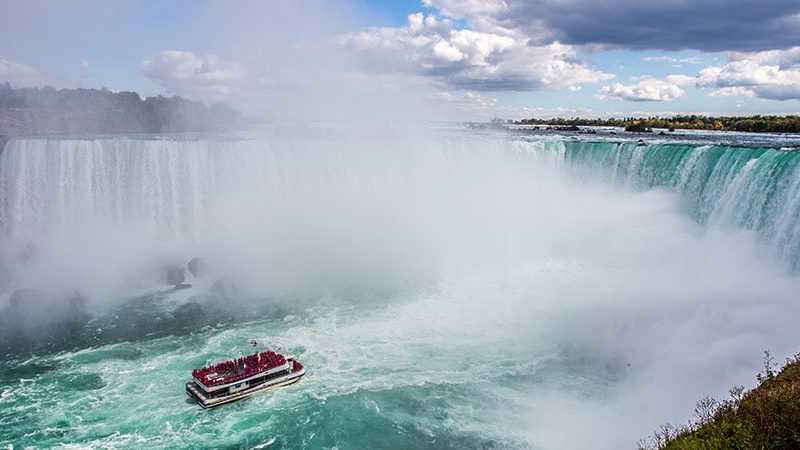5 Interesting Facts About the Niagara Falls


On one of the most southern tips of Canada, in the province of Ontario, you will find the Niagara Falls. The Niagara River forms a natural border with the USA, separating Ontario from the New York State. This unique place has three massive waterfalls plunging into a deep natural gorge. Indeed it is one of the most spectacular natural wonders on mother earth.

The name Niagara comes from a native tribe called Onguiaahra, which morphed into “Niagara” in the speech of French explorers. It has become one of the most iconic landmarks in North America.
And now, five interesting facts about the Niagara Falls:
1. They Are Really, Really Huge
The sheer size of the Niagara Falls is key to their popularity. They give us an idea of how small we actually are. The three different waterfalls that make up the Niagara Falls are the Horseshoe Falls, the American Falls and the Bridal Veil Falls.
The total width of the falls is 1.2 kilometres. Most waterfalls are thin and narrow. Therefore, the massive width of the Niagara falls is what sets them apart. From the highest point on the ridge, the water plunges 57 metres. The gorge below is 11 kilometres long. The deepest point in the river below, 51 metres, is under the Horseshoe Falls on the Canadian side of the border.

Therefore, in size and capacity, they rank among the biggest waterfalls in the world.
2. People Love Doing Stunts There
This practice harks back to different times when performing stunts was a popular form of entertainment. The Niagara Falls has provided a perfect location for those who like to test the line between courage and stupidity.
Sam Patch, a.k.a. the Yankee Leaper apparently started this, when he took a 26-metre dive down Horseshoe Falls in 1829. The first person to cross the gorge on a tightrope was Charles Blondin (1989). Not one to rest on his laurels, he performed the same feat while blindfolded, pushing a wheelbarrow. In 1901, Annie Edson Taylor became the first person to go over the falls in a barrel. In 1951 it became illegal to perform stunts at Niagara Falls. Therefore, the number of stunts performed has since dropped drastically. However, even a stiff fine does not completely deter the occasional attempt.
3. They Are The Oldest Tourist Attraction In North America
In the early 1800s, with travel becoming more accessible, more tourists started visiting the Niagara Falls. With more significant numbers of tourists came the need for accommodation, transport and extra entertainment.
This trend has continued until present times. An estimated 30 million people visit the Niagara Falls each year. The tourist industry is well-developed and caters for a wide variety of budgets and tastes. As a result, hotels, casinos, golf courses – even wine tours – are at your fingertips.

A visit to the falls would, of course, be the highlight of the trip. The closest Canadian international airport is in Toronto, which is about an hour’s drive away. Public transport from Toronto is also available. Therefore, even if you only have one day, you can still go and see the majestic falls.
There are many viewing options too. One can get up close in a boat on a river, or enjoy spectacular views from many well-placed viewing spots.
Do some research about the area before you go there, as there are unique cultural features that don’t always end up in the brochures. For example, you can take yourself on a tour of the many historic bridges at Niagara Falls. Alternatively, you could take a hiking trail above or below the falls. Additionally, a “journey behind the falls” could also be a unique experience.
4. It Takes A Lot Of Water To Create That Splendour
The amount of water that flows through the Niagara Falls is staggering. It clocks in at 168 000 cubic metres per second. This amount is equal to about 70 Olympic-size swimming pools – every second. The water rushing past reaches an impressive speed of up to 109 kilometres per hour.
The Great Lakes form one of the biggest freshwater systems on the planet. The system is fed continuously by melting ice, snow, rain and secondary rivers. The Niagara river joins two of the Great Lakes, Lake Eirie and Lake Ontario. Water flows from Lake Eirie to Lake Ontario, a drop of 99 metres. Around half of this drop occurs at Niagara Falls. Moreover, the massive amount of water rushing past at such great speeds generates a lot of energy, which brings me to the next fact.

5. Niagara Falls Supply A Massive Amount Of Clean Electricity
The electricity generated at the Niagara falls is enough to supply 25% of the entire need of New York State and Ontario. Furthermore, generating this electricity does not harm the earth in any way. To their credit, people realised this potential as early as 1895.
The celebrated electrical engineer, Nikola Tesla, was instrumental in setting it up. What’s more, there is a small monument in Tesla’s honour on Goat Island at the bottom of the gorge. The flow of water at Niagara falls is controlled by a massive diversion system. As a result, authorities can cater to both tourism and electricity generation.


